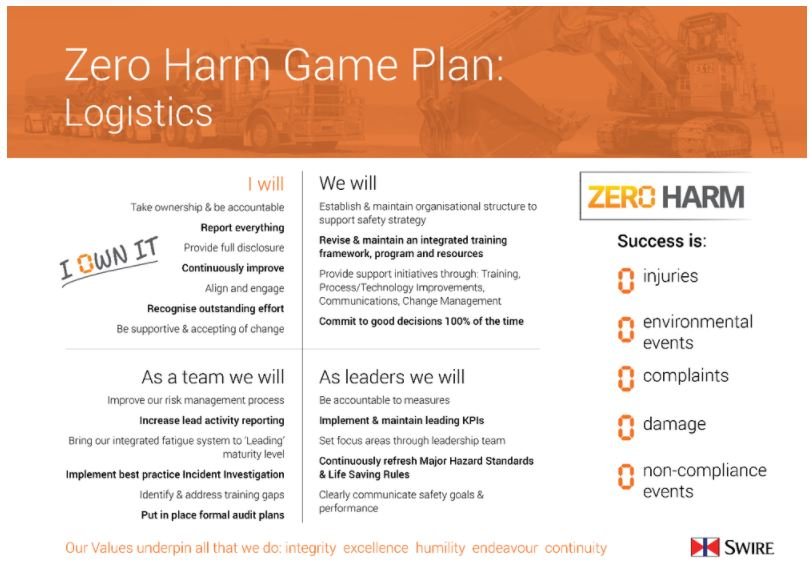FAQ
Where does the Zero Harm Game Plan come from?
The Kalari Safety Summit of 2016 resulted in a number of priority Safety Projects, e.g. Improved Risk Assessments, Major Hazard Standards review, Training Program update.
At the same time it was recognised that we did not have a single reference document that describes the Logistics’ business’ safety strategy, what we are trying to achieve in safety, and the roles of everyone involved.
Manager Director Peter O’Shannessy commissioned a working team with GM Safety Damian Bassett as the Subject Matter Expert to develop a document describing our goals and strategy based upon the model of the Kalari Game Plan.
The working team included the Operational GMs (David Haynes, Leigh Barry, Garry Jakovich, Darren Whyte), Andrew Maxwell as a Regional Manager, Kelly Christensen as an HSSE Manager, Clare Gianchino as facilitator and Peter Hardy as a Trainer / Assessor.
Why Zero Harm?
The working team’s first objective was to redefine the Vision Statement for the business around Safety.
They agreed that we will clearly state that we are Targeting Zero Harm.
Zero Harm is in alignment with the Swire messaging, that of the Kalari HSE Mining division and most of our clients.
What about Goal Zero?
What is ‘I Own It’ about?
In defining the vision of Targeting Zero Harm the working group reviewed the Safety Vision or Commitment statements of many other benchmark organisations, and we determined that a simple, short and personal message was best. The statement of ‘I Own It’ with the Zero replacing the ‘O’ is a mantra we will all commit to - when it comes to anything to do with safety, health, environment and compliance we each have ownership.
What are the measures?
In defining the Game Plan we have defined the measurements of success for not just safety but all elements of Zero Harm within the Kalari HSE Logistics business: Zero Injuries, Zero Environmental Events, Zero Complaints, Zero Damage and Zero Non-Compliance Events.
What are the different elements?
The elements of the full Game Plan below are the key processes, behaviours and cultural aspects that support the effort to achieve Zero Harm.
For our managers, supervisors, advisers and trainers in the business we expect that they will understand their role in all the elements of the Game Plan above.
Under ‘We Will’ it describes the fundamental aspects that we all need to engage with and deliver – structure, training, technology, communication and change management. We also commit to good decisions 100% of the time (a commitment that our Mining division has used as a key safety message for many years).
As a team we will work across functions, operations, workshops, depots, and National Office to improve our systems: risk management, leading metrics, fatigue management, incident investigation, training and audits.
As leaders we will measure Zero Harm by leading and lagging KPIs, set goals for these measures and be accountable for them. These measures we be used by the leadership team along with emerging issues to define the focus areas for the business. The leaders also commit to refreshing the Major Hazard Standards and Life Saving Rules; something which is also resulting in a rollout of revised Rules at the same time as this Game Plan.
What do we want the frontline employees and contractors to understand and commit to?
For the drivers, mechanics and administrators we expect that they understand the aspects of the simplified Game Plan which will be posted around the sites, as seen below:
It clearly defines what Zero Harm Success is.
It also describes that when we state ‘I Own It’ this means that each individual in the Kalari HSE business, no matter their position, will:
· Take ownership and be accountable for Health, Safety, Security, Environmental and Compliance aspects that they can control.
· Report everything including minor injuries, near misses, damage, spills, and non-compliant behaviours.
· Provide full disclosure about events relating to Health, Safety, Security, Environmental and Compliance.
· Seek to continuously improve.
· Align with the Zero Harm goals of the business and the commitments of the seniors leaders.
· Engage and feel positively about the organisation and make discretionary efforts to achieve Zero Harm.
· Recognise others for outstanding efforts.
· Be supportive and accepting of the changes that are required for the business to achieve Zero Harm, some of which will be quite challenging.



